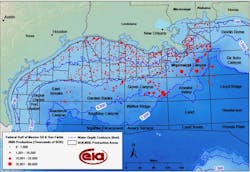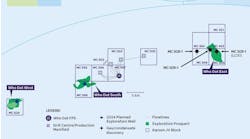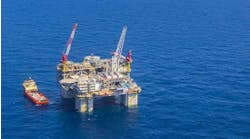Operators update US GoM development plans
Offshore staff
HOUSTON — Oil and gas upstream activity in the US Gulf of Mexico could pick up in 2021 even as production is expected to dip slightly, according to a report by S&P Global Platts.
The report, issued in mid-January, came out before President Biden’s move to ban new oil and gas permits for 60 days.
The report quoted Justin Rostant, a Gulf of Mexico analyst for Wood Mackenzie, as saying that as many as 60 new deepwater wells could be drilled this year in the GoM, excluding side tracks and bypass wells, as compared to 52 in 2020 and 60 in 2019. “We expect 2021 to recover somewhat, so we should see well activity rise,” Rostant was quoted to say.
US Gulf operators applied for 75 drilling permits for US Gulf wells in 2019 (52 for wells deeper than 3,000 ft), but this fell to 61 last year (46 for wells deeper than 3,000 ft), said Sami Yahya, an S&P Global Platts Analytics analyst.
Following the crude price decline in 2020, and several US Gulf project delays, offshore operators should largely focus this year on development drilling rather than exploration, Yahya added.
“There will be some potential exploration baked in if there are already contracts in place,” Yahya was quoted to say. “But operators are trying to figure out their footing, at least for the first half of 2021. [They] have plenty of development work available to keep them busy for the rest of the decade.” Activity may pick up in the second-half 2021, Yahya added.
Average breakevens for the deepwater US Gulf have dropped substantially in recent years to about $47/bbl in 2020 from $68/bbl in 2014, and are not much above US shale’s $43/bbl, according to Platts. Both have full-cycle project breakeven costs of $50/bbl. That compares to $40/bbl in for deepwater Brazil last year and $49/bbl for the North Sea.
Shell and BP were slated to each bring on projects this year, but the status of some projects is uncertain. First oil from Shell’s Vito field, with peak output estimated at 100,000 boe/d, was slated to come online this year but has been postponed to 2022 after a three-month scale-back to prevent spread of the coronavirus, according to a Shell spokesperson. The company’s PowerNap field startup, with a projected 35,000 boe/d of peak output, was similarly postponed to 2022 on pandemic concerns.
Shell’s Perdido Phase 2 well achieved first oil in early January; the well is tied back to the Perdido hub. It is the first of four wells expected to come online this year at that project.
BP’s 140,000 b/d Mad Dog 2 project, as well as its 50,000 boe/d Thunder Horse South Phase 2, were scheduled to come online in 2021, although some sources believe these could be pushed back to 2022 for similar reasons.
Yahya said the delays of the larger fields may not matter much to 2021 production in any case.
“Mad Dog 2 and Vito were coming online in late 2021, so their true impact to production [wouldn’t] be felt until well into 2022 anyway, given a required ramp-up period that could take many months,” he was quoted to say.
In addition, an assortment of smaller fields are expected online this year, such as Murphy Oil’s Calliope, at around 7,000 boe/d, and Ourse at around 6,500 boe/d, according to the S&P Global Platts report.
The ramp-up of fields that came online in 2020 but whose start-ups were interrupted by last year’s hurricane season will provide a boost to 2021 output. For example, Talos Energy’s Bulleit field, estimated around 15,000 b/d, started up late last year, and the company's Kaleidoscope field was also due to come online in November, but a series of storm-related shut-ins delayed startup or resumption.
This year, Shell expects to sanction its deepwater Whale project and Total is expected to green light its North Platte field (75,000 b/d at peak), although Rostant believes North Platte will not be approved until 2022.
Several operators have made plans to resume their drilling campaigns in the deepwater Gulf this year. Equinor is expected to drill an appraisal well at its Monument discovery. LLOG Exploration has plans to conduct development drilling on its existing fields. And Hess, which had paused its drilling the Gulf in 2020, is expected to renew its exploration efforts this year.
But President Biden’s recent move to ban new oil and gas permits for 60 days has placed an air of uncertainty on future E&P activity in the Gulf.
01/25/2020



